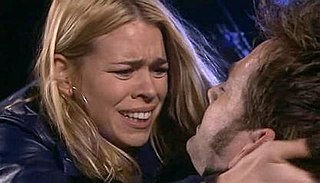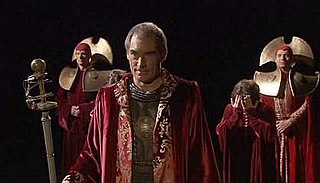
Rose Tyler is a fictional character in the British science fiction television series Doctor Who. She was created by series producer Russell T Davies and portrayed by Billie Piper. With the revival of Doctor Who in 2005, Rose was introduced as a new travelling companion of the series protagonist, the Doctor, in his ninth and tenth incarnations. The companion character, intended to act as an audience surrogate, was key in the first series to introduce new viewers to the mythos of Doctor Who, which had not aired regularly since 1989. Rose became the viewers' eyes into the new world of the series, from the companion's perspective. Piper received top billing alongside Christopher Eccleston and David Tennant for the duration of her time as a regular cast member. The character was a series regular for all of Series 1 (2005) and 2 (2006). Piper later reprised the role in a supporting capacity in Series 4 (2008) and the New Year's special "The End of Time" (2010). Piper further played a sentient weapon called the Moment, which utilises Rose's image, in the 50th anniversary special "The Day of the Doctor" (2013).
"The End of the World" is the second episode of the first series of the British science fiction television programme Doctor Who. Written by executive producer Russell T Davies and directed by Euros Lyn, the episode was first broadcast on BBC One on 2 April 2005 and was seen by approximately 7.97 million viewers in the United Kingdom.

The Tenth Doctor is an incarnation of the Doctor, the protagonist of the British science fiction television series Doctor Who. He is played by David Tennant in three series as well as nine specials. The character has also appeared in other Doctor Who spin-offs. Tennant's time as the Tenth Doctor is highly regarded among fans of the show and is considered one of the most iconic incarnations of the character, often ranked alongside Tom Baker's Fourth Doctor. Tennant would also portray a part-human duplicate of the Doctor known as the Meta-Crisis Doctor, and later return to the series as another incarnation, the Fourteenth Doctor.

Mickey Smith is a fictional character in the BBC One science fiction television series Doctor Who. He is portrayed by British actor Noel Clarke and was the show's first televised black companion. The character is introduced as the ordinary, working class boyfriend of Rose Tyler, a London shopgirl who becomes a travelling companion to the Ninth and Tenth incarnations of an alien Time Lord known as the Doctor. Mickey first appears in the first episode of the 2005 revival, "Rose". Initially someone who struggles in the face of danger, Mickey nevertheless acts as an Earth-based ally to the Doctor and Rose. In the second series he joins the pair as a second companion of the Doctor's, though he leaves during the 2006 series to pursue his own adventures. He returns to aid the Doctor and Rose in the series finale later that year, and then again for the 2008 finale "Journey's End," as well as fleetingly in 2010 in the Tenth Doctor send-off "The End of Time".

Captain Jack Harkness is a fictional character played by John Barrowman in Doctor Who and its spin-off series, Torchwood. The character first appears in the 2005 Doctor Who episode "The Empty Child" and subsequently features in the remaining episodes of the first series (2005) as a companion to the series' protagonist, the Doctor. Subsequent to this, Jack became the central character in the adult-themed Torchwood, which aired from 2006 to 2011. Barrowman reprised the role for appearances in Doctor Who in its third, fourth, and twelfth series, as well as specials "The End of Time", and "Revolution of the Daleks".
"School Reunion" is the third episode in the second series of the British science fiction television series Doctor Who. It first aired on BBC One on 29 April 2006.
"New Earth" is the first episode of the second series of the British science fiction television series Doctor Who. It was first broadcast on BBC One on 15 April 2006.

Harriet Jones is a fictional character played by Penelope Wilton in the long-running British science fiction television series Doctor Who. Having worked previously with lead writer and executive producer Russell T Davies, Wilton was keen to involve herself with his 2005 revival of Doctor Who after he sought to cast her. Jones is introduced in the two-part story "Aliens of London" and "World War Three" as a Member of Parliament who aids the Ninth Doctor against an alien invasion of London. The episode establishes a running joke associated with the character which would see her frequently introduce herself by holding up her ID and stating her name and rank; in subsequent episodes this was usually met with the response "Yes, I/we know who you are," even occurring with the Daleks and the Sycorax.

Martha Jones is a fictional character played by Freema Agyeman in the long-running British science fiction television series Doctor Who and its spin-off series, Torchwood. The show's first female black companion, she is a companion of the Tenth Doctor in Doctor Who, after Rose Tyler but before Donna Noble. According to the character's creator Russell T Davies in his non-fiction book Doctor Who: The Writer's Tale, Martha was developed from the beginning with the intention of appearing for the whole of the 2007 series, and to later make guest appearances in subsequent series and crossover appearances in the show's two spin-offs; Martha subsequently made guest appearances in Torchwood series two and in Doctor Who series four in 2008 and special episode "The End of Time" in 2010. Martha was also intended to make guest appearances in the 2009 series of Torchwood and The Sarah Jane Adventures, but could not due to the actress's other work commitments.
"Smith and Jones" is the first episode of the third series of the British science fiction television series Doctor Who. It was first broadcast on BBC One on 31 March 2007. It sees the debut of Freema Agyeman as medical student Martha Jones. Agyeman had previously appeared as Martha's cousin Adeola in the 2006 episode "Army of Ghosts". The episode also introduced Martha's family, her mother Francine, father Clive, sister Tish, and brother Leo.
"The Shakespeare Code" is the second episode of the third series of the revived British science fiction television series Doctor Who. It was broadcast on BBC One on 7 April 2007. According to the BARB figures this episode was seen by 7.23 million viewers and was the fifth most popular broadcast on British television in that week. Originally titled "Love's Labour's Won", the episode was re-titled as a reference to The Da Vinci Code.
"Last of the Time Lords" is the thirteenth and final episode of the third series of the revived British science fiction television series Doctor Who. It was broadcast on BBC One on 30 June 2007. It is the last of three episodes that form a linked narrative, following "Utopia" and "The Sound of Drums".
"The Sontaran Stratagem" is the fourth episode of the fourth series of the British science fiction television series Doctor Who, which depicts the adventures of a time-travelling humanoid alien known as The Doctor. The episode was broadcast on BBC One on 26 April 2008. The episode and its sequel, "The Poison Sky", were written by Helen Raynor, who previously wrote the linked episodes "Daleks in Manhattan" and "Evolution of the Daleks" in the third series.

"Journey's End" is the thirteenth and final episode of the fourth series of the British science fiction television series Doctor Who, which was first broadcast on BBC One on 5 July 2008. It is the second episode of a two-part crossover story featuring the characters of spin-off shows Torchwood and The Sarah Jane Adventures, preceded by "The Stolen Earth", which aired on 28 June. At 65 minutes in length, it was approximately 20 minutes longer than a standard fourth-series episode. It marked the final regular appearances of every companion introduced in the Russell T Davies era, including Catherine Tate as Donna Noble.

The fourth series of British science fiction television programme Doctor Who was preceded by the 2007 Christmas special "Voyage of the Damned". Following the special, a regular series of thirteen episodes aired, starting with "Partners in Crime" on 5 April 2008 and ending with "Journey's End" three months later on 5 July 2008. The series incorporates a loose story arc consisting of recurring mentions of the disappearance of various planets and moons.

The third series of the revived British science fiction programme Doctor Who, and the twenty-ninth season of the show overall, was preceded by the 2006 Christmas special "The Runaway Bride". Following the special, a regular series of thirteen episodes was broadcast, starting with "Smith and Jones" on 31 March 2007 and ending with "Last of the Time Lords" on 30 June 2007. In addition, a 13-part animated serial was produced and broadcast as part of Totally Doctor Who.

The second series of British science fiction programme Doctor Who began on 25 December 2005 with the Christmas special "The Christmas Invasion". Following the special, a regular series of thirteen episodes was broadcast, starting with "New Earth" on 15 April 2006. In addition, two short special episodes were produced; a Children in Need special and an interactive episode, as well as 13 TARDISODEs. It is the second series of the revival of the show, and the twenty-eighth season overall.

"The Stolen Earth" is the twelfth episode of the fourth series and the 750th overall episode of the British science fiction television series Doctor Who. It was first broadcast on BBC One on 28 June 2008. The episode was written by show runner and head writer Russell T Davies and is the first of a two-part crossover story with spin-offs Torchwood and The Sarah Jane Adventures; the concluding episode is "Journey's End", the finale of the fourth series, broadcast on 5 July.

"The End of Time" is a two-part story of the British science fiction television series Doctor Who, originally broadcast in the United Kingdom on BBC One on 25 December 2009 and 1 January 2010. It is the fifth Doctor Who Christmas special and the last entry in a series of specials aired from 2008 to 2010. It marks the final regular appearance of David Tennant as the Tenth Doctor and introduces Matt Smith as the Eleventh Doctor. At the time, it was the last Doctor Who story written and produced by Russell T Davies, who shepherded the series' return to British television in 2005 and served as the series's executive producer and chief writer; he would later return to that role in 2022 for the 60th anniversary specials and beyond. Davies was succeeded as executive producer and showrunner by Steven Moffat.














